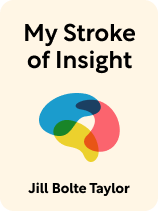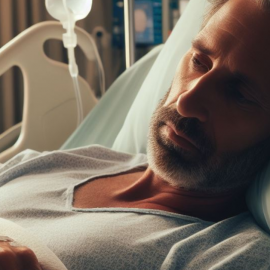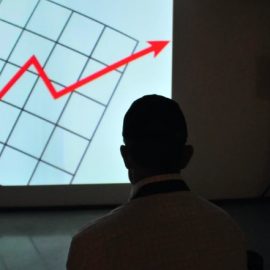

This article is an excerpt from the Shortform book guide to "My Stroke of Insight" by Jill Bolte Taylor. Shortform has the world's best summaries and analyses of books you should be reading.
Like this article? Sign up for a free trial here.
What’s it like to have a stroke? What happens afterward? How can you best recover from a stroke?
When neuroscientist Jill Bolte Taylor suffered a stroke on the left side of her brain, she was uniquely qualified to observe and report on the experience of losing her cognitive functions. However, she was surprised by what she learned—and gained.
Keep reading to discover the amazing story of Jill Bolte Taylor’s stroke and recovery.
Jill Bolte Taylor’s Stroke & Recovery
Jill Bolte Taylor’s stroke came as a surprise, of course. But she also was surprised by what she learned from the experience. As a neuroscientist, Taylor was aware of the biological processes involved with a stroke, but it was a different thing entirely to experience one firsthand.
On the morning of December 10, 1996, between the time she woke up and when she would have left for work, an undiagnosed AVM ruptured and bled into Taylor’s brain’s left hemisphere. After years of recovery, Taylor has reconstructed her actions, thoughts, and feelings immediately during and after her stroke, and she recounts the painstaking process that followed in order to regain her cognitive abilities.
During the Stroke
Even with Taylor’s professional background, the fact that she was having a stroke wasn’t immediately apparent. Once she realized what was happening, Taylor used what mental and physical strength she had left to call for help while observing what was taking place in her mind. Throughout that morning, she experienced increasing symptoms of stroke and systematically made use of the faculties she had left to plan and enact a way to rescue herself.
The first symptom she felt was a stabbing pain behind her left eye, followed by an increasing sense of disconnection from her body. As she moved around her apartment, she felt that she was unusually conscious of having to direct the muscles in her legs. Normal levels of light and sound seemed unnaturally bright and loud. Taylor says she started to guess that her symptoms must have had a neurological cause, but that the constant babble of her mind’s inner voice had gone strangely silent. At first, she was unable to diagnose herself and was distracted by a growing sense of oneness with the world. It was only when her right arm ceased to function that she realized she was having a stroke.
(Shortform note: There are several medical and neurological conditions with symptoms that can mimic those of a stroke. These conditions include epilepsy, brain tumors, and biochemical imbalances. Because as many as one in five potential stroke cases are in fact something else, it’s important for doctors to make the correct diagnosis before treatment. If you or someone close to you is experiencing neurological symptoms, though, do not “wait and see” if they go away. Of the many stroke symptom acronyms to remember, the most on-point is probably BE FAST: Balance, Eyes, Face, Arms, Speech, Time to call emergency services.)
Taylor reports that her immediate reaction was an unexpected sense of pleasure at being able to watch a stroke from the inside out. However, her dying left brain insisted that she had to get help. Unfortunately, she couldn’t use the phone to call for an ambulance because she’d lost the ability to comprehend numbers. Concentration grew painful, but her right brain offered feelings of peace and blissful tranquility. During her lucid moments, which grew further apart, she devised a plan to call a colleague at work. Because she’d dialed his extension many times, some of that memory was stored in her right brain as the pattern that the numbers formed on the phone’s touchpad.
Nevertheless, it took many tries to pull the right sequence of numbers from her thoughts and scribble them down with her left hand. (Taylor is right-handed, but her right hand was useless.) Because her right brain could still think in pictures, she had to go through the painstaking process of matching the shape of the numbers she’d written to the shape of the numbers on the phone. She was unable to speak when her colleague answered, but he was able to deduce she was in trouble and arranged for an ambulance to come to her rescue. Once she was on her way to the hospital for treatment, Taylor says that she lost any sense of her body, and her mind completely shut down.
(Shortform note: Taylor was acutely aware that time was of the essence in minimizing the damage to her brain. Proper medical treatment must begin as soon after a stroke as humanly possible. For this reason, if you’re with someone having a stroke, help keep them awake, don’t give them food or drink (the stroke may impair their ability to swallow), don’t give them any medication, and wait for first responders. To be effective, stroke treatment must begin within a few hours of the onset of symptoms, but it cannot begin until the stroke has been diagnosed and imaged with a CT scan. Only when the type and location of the stroke have been identified can doctors determine the appropriate treatment.)
After the Stroke
On the afternoon of the day of her stroke, Taylor woke to an entirely different sense of awareness than she’d ever felt before. Though her left brain was dying and in shock, her right brain was fully aware and cognizant. Taylor recounts the experience of being in the world from a purely right-brain perspective and how it affected her physically, emotionally, and intellectually.
Her first sensation was a tremendous amount of pain, and not just in her head. Her senses seemed extremely sharp so that every sound, light, and touch was nearly too much to bear. Beyond that, she realized that she no longer had any sense of her body’s physical boundaries. Instead, she felt like a liquid part of a universal continuum that included everything around her. Taylor recalls that she perceived herself as a being of energy tied to a painful material husk, and her energy was severely depleted. Every interaction with other people in the hospital threatened to drain her energy even more, prompting a desire to withdraw inside herself.
(Shortform note: Some of the sensations Taylor describes, such as an overwhelming feeling of peace and a sense of disconnection from her own body, are similar to those reported by people who’ve had near-death experiences and complex partial seizures in which portions of the brain go dormant while others remain fully active. Likewise, people who’ve taken psychedelic drugs report a weakened sense of self and a feeling of connection with everything around them. Because certain psychedelics, such as psilocybin and DMT, can reduce neural inflammation and promote neuroplasticity, doctors are currently exploring the possibility of using psychedelics as a recovery treatment for stroke survivors.)
However, Taylor also remembers feeling a great sense of peace between moments of painful intrusions from the world. Her left brain had shut down, but her right brain was fully active and conscious. Because the right hemisphere doesn’t perceive time, she experienced her existence fully “in the moment,” with no memory of the past. In that sense, she had regressed to the nonverbal mental state of an infant who lives in a perpetual “now.” Because her right brain was fully engaged, she was very aware of the body language of the people around her. If they were gentle and caring, they restored her sense of energy, but if they were anxious or hurried, she felt they depleted what reserves she had left.
(Shortform note: Connecting with other people’s emotions and feeling them yourself is a real biological process. In The Whole Brain Child, Siegel and Bryson identify specific cells called mirror neurons that reflect and absorb the actions and emotions you see expressed around you. For example, if you see someone near you get angry, your mirror neurons activate as if you’re the one who’s angry. When Taylor’s left brain was damaged, she lost the cognitive ability to differentiate between others’ feelings and her own. If her mirror neurons reflected the tenderness or anxiety of the people around her without the filter of her left brain’s sense of self, it may have heightened her sensitivity to those feelings.)
Taylor says she was struck by the silence she now experienced in her mind. She recognized that her brain was no longer functioning normally. But, without her left brain’s sense of ego, she didn’t feel any grief. With very little access to language, when someone spoke she had to absorb each word as an individual unit and puzzle them together in a painstaking process. Without her left brain’s ability to catalog and order her sensations, she had to focus on each individual sense and make a concerted effort to identify what every incoming signal told her. Interacting with the world was a painful distraction from the deep, inner calm that her right brain continued to offer as an alternative.
(Shortform note: Taylor’s description of her stroke is vivid, but it isn’t the only post-stroke account, nor is it descriptive of every stroke experience. The CDC, AARP, and the Stroke Awareness Foundation offer stories from a variety of stroke survivors, including those of a man whose first symptoms were cramps in his left arm and leg, an attorney who experienced a series of mini-strokes, and a businessman whose gut instincts warned him that his symptoms were more serious than his emergency room doctors initially believed.)
Recovery Begins
Despite the temptation to sink into the bliss of mental silence, Taylor understood how important it was to keep her mind active in order to have any chance of regaining her cognitive abilities. During the immediate post-stroke recovery period, she focused on maintaining her energy, challenging her language skills, and strengthening her body and mind enough to undergo surgery to remove the mass of blood that had congealed in her head.
Taylor explains that the doctors and nurses who treated her weren’t cognizant at all of how their interactions depleted her energy, so she took responsibility for managing her reserves. If hospital staff treated her gently, she would respond and cooperate with what they wanted. However, if they were forceful and taxing, she would ignore them as much as she could. She discovered that sleep was the most important factor in restoring her energy levels, so she learned to respect her body’s need for rest.
(Shortform note: Even for people who haven’t suffered brain trauma, sleep is vital to human cognition. In Brain Rules, biologist John Medina explains that in addition to maintaining your biological rhythms, sleep plays a role in encoding information into memory, helping you retain what you learned while awake by solidifying new cognitive pathways. He says that sleep also lets the brain flush out toxic chemicals that build up throughout the day, creating a fresh mental slate with which to process even more information when you wake.)
Unlike sleep, the act of thinking was a great drain on Taylor’s energy, but she knew that keeping her brain active was also vital to the recovery process. To exercise her mind, Taylor worked to regain control of her body and her ability to speak. But, even the simplest tasks, such as walking or speaking simple words, were too much to tackle all at once. Taylor describes the process she went through to break every physical or mental action down into its smallest possible steps.
She uses the example of getting out of bed, for which she first had to master the skill of rocking back and forth. Once she could rock her body in successively greater increments, she could then move on to the next step of rolling into an upright position. For mental tasks, her caregivers focused on multiple-choice questions, rather than simple yes-or-no answers, as a means to reactivate her dormant mental connections.
(Shortform note: In Brain Rules, Medina says that even the act of paying attention to something is a multistep process, much like getting out of bed. Different parts of the brain must activate in sequence—alerting you to stimuli, orienting your awareness toward it, then engaging your higher brain functions. He argues that splitting your focus doesn’t work, especially in situations when concentration is vital. Attempting to multitask presents the brain with a constant stream of interruptions, after which the attention process must repeat itself again and again. For Taylor, focused concentration was absolutely essential because she had to relearn every step of every process she’d previously taken for granted.)
It was important for Taylor to regain as much energy and cognitive function as she could to improve her chances of successfully coming through a surgery that was needed to repair her AVM and remove the mass of blood from her left hemisphere. At that point, says Taylor, only some of her brain cells had died but many more were still in a state of shock. While the surgery was needed to prevent further damage, it ran the risk of taking away her capacity for language or bodily control completely. Nevertheless, two weeks after her stroke, Taylor’s surgery was a success. When she woke afterward, she felt emotionally lifted, and she retained the power of speech she’d worked so hard to regain.
(Shortform note: While any surgery comes with an amount of risk, operating on the brain is especially dangerous. Potential side effects include mental impairment, swelling, bleeding, infection, and another stroke. As part of the recovery process, doctors have to continually assess the patient’s neurological and physical functions, as well as take measures to ensure that harmful blood clots don’t form. Once released, the patient and their caregivers must be alert for signs of worsening cognition or physical pain that may warrant a return to the hospital.)
Surgery didn’t guarantee that Taylor would regain enough of her cognitive abilities to function as a fully independent person. In fact, it took eight years of dedicated work—rebuilding memories, vocabulary, motor functions, and scientific knowledge—for Taylor to reach the point where she considered herself to be fully recovered from her stroke. Some of that work included reconstructing her memories of the stroke in light of her restored left-brain functions.
Taylor is careful to point out that how she defines “recovery” is subjective. She hasn’t regained every skill, memory, or emotional response, and some of that has been deliberate. As she relearned who she was and how to live, the stroke gave her the opportunity to choose who this new version of herself would be and to leave behind parts of her previous life that she didn’t want anymore.
(Shortform note: Though Taylor eschews standardized stroke recovery timelines, the medical community offers guidelines to manage expectations for stroke survivors and their caregivers. Johns Hopkins Hospital suggests that the first three months are crucial for healing and recovery, while improvements will proceed more slowly after six months from the stroke. Physical therapist Signe Brunnstrom established a series of benchmarks used to determine progress in body coordination and mobility. The Stroke Recovery Foundation provides a cognitive and emotional to-do list for recovery without attaching time expectations.)

———End of Preview———
Like what you just read? Read the rest of the world's best book summary and analysis of Jill Bolte Taylor's "My Stroke of Insight" at Shortform.
Here's what you'll find in our full My Stroke of Insight summary:
- A neuroscientist's experience and observations after suffering from a stroke
- How the author's stroke helped her develop empathy and stillness
- How best to support stroke survivors






